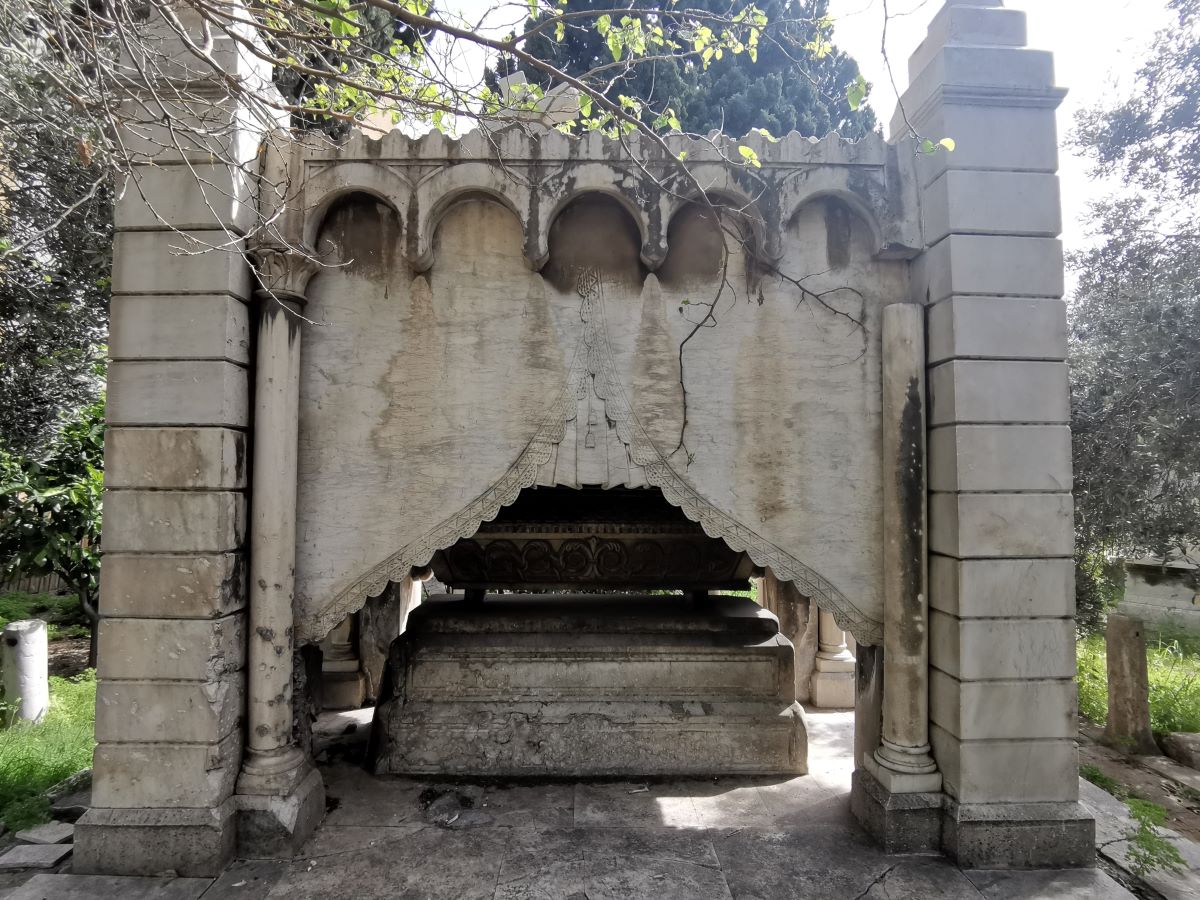Hazmieh town houses a unique cemetery that date back between the 19th and the 20th century AD.
Description
The cemetery of Hazmieh was an official Ottoman graveyard for the governors (Mutassarif) of Mount-Lebanon and their close relatives. It is unique in Lebanon as it contains the remains of both Muslims and Christians buried in one place.
The most notable characteristic of the people buried in the cemetery is the wide and shifting range of identities represented. For example, religious affiliations include Maronite, Protestant, Muslim, Greek Orthodox, and Roman Catholic, while national identities held include British, Albanian, Ottoman, Armenian, Arab, Italian, and Syrian.
Most of the monuments have damage from gunfire which probably occurred during the Lebanese civil war when the cemetery was located on the Green Line at the edge of east Beirut before its relocation to the actual place.
Tombs
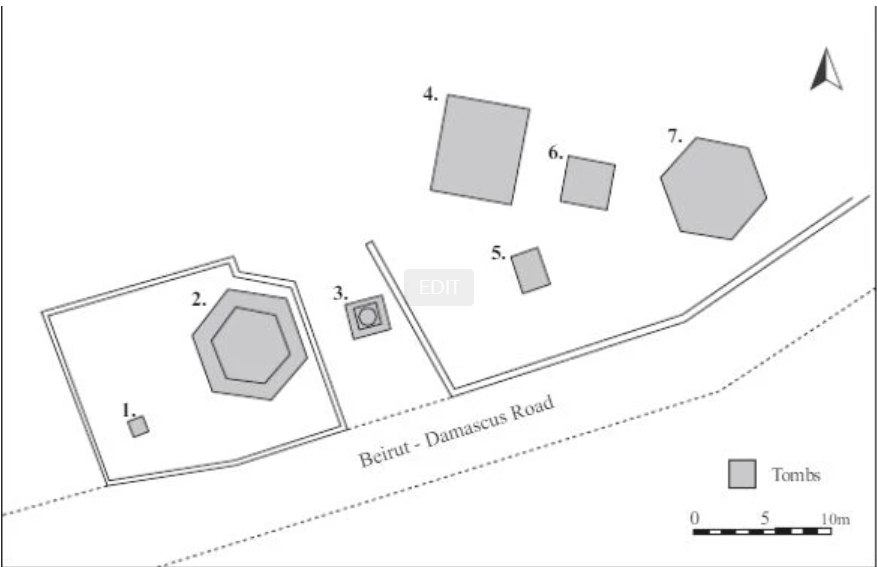
Tomb No.1 – Melhem Bey Abu Shaqra: born at the palace of Beit-El Din, the official residence of the Ottoman governors of Mount Lebanon, Melhem Bey joined the military from his early age and was promoted to the rank of Mirlay (Brigadier General) in the Ottoman army.
The tomb comprises a square base of dressed limestone above which there is a marble plinth with inset inscription panels on each side. The monument is clearly an imitation of Roman funerary altars. Each of the inscriptions is flanked by a carved depiction of an inverted torch symbolizing the end of life. The upper part of the plinth has a cyma recta cornice surmounted by a vegetal frieze with raised corners. The top most part of the structure comprises a square block with a flat table like top. The sides of the square block are ornamented with carved depictions of laurel garlands.
Inscription east face (French) CİGİT MELHEM BEY ABOU CHACRA COLONEL DE LA MİLİCE LİBA_ NAİSE NE À BEİTE_ DDİNE EN 1845 EN_ ROLE 1862 COLONEL 1897 DÉCÉDÉ LE 19 FÉV 1904 PRİEZ POUR LUİ
Inscription west face (Arabic) يا ضريحاً في الحازميه يبكي حولى الجند والقناو الجياد بين رمسين للوزير رحتو ك لليث تتهابر الأساد قدر جل فاست وال شقرا وسوا عمر في هول رها البلاد يالتاريخ فقد ملحم بيك حظر القوم حمرة لا المداد ١٩٠٤
Translation: This monument in Hazmieh weeps [For the one who] kept the army in the right direction According to the wishes of the minister To ensure that you welcome peace Which is the destiny of the fair people To flourish in ???? fear of the country The day of loosing Melhem Bey Will not be forgotten by the people of Hamra 1904
Inscription south face (Arabic) يا زائرين ضريح أشهر قائد في جند لبنان قفوا في ذا الحمى واتلوا السلام على شجاع راقد في الحازميه شاخصا نحو السماء بطل ابو شقرا بنفس حرة قد جد فاكتسب المعالي مغنما أبقى له في جنده تاريخه ذكرا يمجد بالشجاعة ملحما ١٩٠٤
Translation: Oh, visitors of the shrine of the most famous general In the army of Lebanon, may you stand in his advocate, So you recite the peace on a brave person who is resting In al-ḥāzimīah and who is rising [his face] towards the heaven. The hero of AbūShaqrā[‘s family], he worked hard while keeping his soul free, And thus he gained the high [positions] as a deserved reward. His history with his soldiers kept his memory [alive] To always praise Melḥem with bravery. 1904
Inscription north face (Arabic) هذا الضريح يضم رفات المرحوم ملحم بك أبي شقرا ميرالاي عساكر لبنان ولد في بيت الدين سنة 1845 ودخل الجندية سنة 1862 وإرتقى فيها بجدارته تدريجياً حتى وصل إلى رتبة ميرالاي سنة 1897 وتوفاه الله 19 شباط سنة 1904 رحمه الله
Translation: This grave contains the remains one who has received God’smercy(marḥūm) Melḥem Bey AbūShaqrā,themīrālāy (brigadier general) of the troops Of Lebanon he was born in Beyt al-Dīn [in] the year of 1845; He joined [the life of] soldiers [in] the year of 1862 and was promoted Because of his merit until he eventually Reached the rank of mīrālāy [in] the year of 1897; Allah fulfilled [his life] on the 19th of February 1904; May Allah have mercy on him.

Tomb No.2 – Ahmad Faris Shidyaq: Born in 1804, Ahmed Faris Shidyaq was a Lebanese author, journalist, editor, and translator and one of the major figures of the nahda or Arabic intellectual renaissance of the late nineteenth century. Faris was brought up as a Maronite and educated at the seminary of Ain Waraqa – he would later on convert to become a protestant and then a Muslim. He died on September 20, 1887 in Kadiköy and was then transported to Beirut where he was buried on October 5, 1887. The funeral was reported in the local press and there was considerable debate both about where he should be buried and also whether he should be buried as a Muslim or a Christian.
This is the largest and most visible of the tombs within the cemetery comprising a hexagonal domed mausoleum built onto a wide terrace or platform of the same shape. The mausoleum is built in a neoclassical style with engaged corner piers ornamented with plain moldings and cornices. On the top of the cenotaph there were originally two upright columns although now only one remains. The column which has now disappeared was decorated with a spiral shaped ivy decoration carved in relief. The surviving column contains a 20 line Arabic inscription which is reproduced below:
هو الباقي وزدت الرحمن بالعفو منهاك وقد فرن من أحساني بالنفاس, وأودعت في هذا الضريح وغورة, وقد كنت في دنيا صدر المجالس, وفي سسائر الأقطار جابت جوائبي بنشر اشمر الطيب, شمر المعاطس وجاوزت في الدنيا ثمانين حجر,ها كنت اجني العلمى زاكي المغارس لذاك أرى بالعلمى حياً ذلغدا أخو الجهل, ميتار سمى شردا رس لأني بى قد عشت اجني فنونى بافنان أدب زهى كالع اسن ومولاي, في دار الخلفى قد قضي علي فقا بلت القضا غيى, عبسن وجت لأوطان ترابي غد ابها, وما أنا من ورد النعيمى باس, لأن هدى مولاي للرشد أرخو,أحد بدار الخلد أحمد فارس وليد في سنة ١٢١٩ وتوفي في محرم سنة ١٣٠٥
Translation: He the Everlasting I sought a river of forgiveness from the Merciful, And I earn the most precious of his kindness. I was entombed in this mausoleum and its profundity, While I was in my life the centre of assemblages, in all the countries my Jawāib roamed a publication that spread fragrance into noses, and I exceeded in the world 80 of age, during which I have garnered knowledge from ripened plants, thus I see living in knowledge, and the associate of ignorance dies, his traces badly effaced Because by it [knowledge] I have lived: picking its arts, from branches of knowledge as bright as brides, and my lord, in the Seat of the Caliphate has finished…me. Yet I met my fate without grimace. And I came to homelands in which my dust settled Though I am not hopeless of entering paradise… Since my Lord’s path is the guided one, note down: Aḥmad Fāris has entered in the Abode of Immortality. Born in 1219 and deceased on 2 Muharram 1305.

Tomb No. 3 – Franco Pasha: Born in 1814 in Constantinople, Franco Pasha first came to Lebanon with Fuad Pasha, the Ottoman official representative sent to investigate the civil war of 1860. In 1863, he was given the title of vizier and was appointed as governor for a period of ten years but died in 1873 leaving four sons one of whom is buried in this cemetery.
The monument comprises a square stepped base and a domed canopy resting on four slender marble columns. The columns rest on square, fluted bases and at the top of each one there is a simplified Corinthian capital. On each side of the monument above the level of the columns there is an entablature decorated with a simple cornice and a swirled motif characteristic of classical Ottoman architecture. Above this there is a circular drum which originally supported a dome which is no longer in place. Internally, the zone of transition is in the form of spherical pendentives.
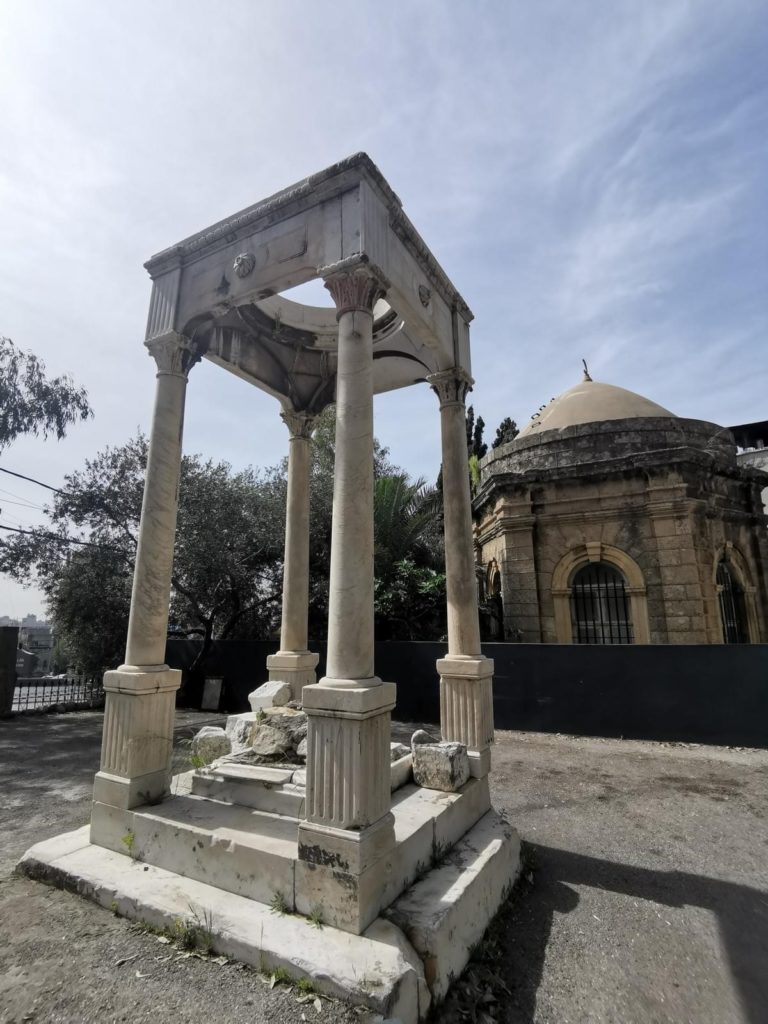
Tomb No.4 – Catharina Wassa Pasha: Catherina was the second wife of Wassa Pasha and like him, originated in the town of Skodra in Albania, although unlike him she was from a Greek Orthodox family. Catherina became ill with tuberculosis and died in 1884.
The monument is the most elaborate of the tombs in the cemetery comprising a cenotaph contained within a rectangular roofed enclosure with the appearance of drapery. The long sides of the monument are decorated in the form of arcaded parapet while each of the short sides has a single arch engraved with the name of the deceased (Arabic at the east end and French at the west end). Inside the structure the cenotaph comprises a rectangular base supporting a full size representation of a coffin decorated with vine scrolls.
Inscription south end (French): A LA MEMOIRE DE MECATHERINE WASSA PACHA
Inscription North End (Arabic): هذا الضريح حرم حضرة صاحب الدولة واصا باشا
Translation: This tomb contains the wife of the Lord of the country Wassa Pasha
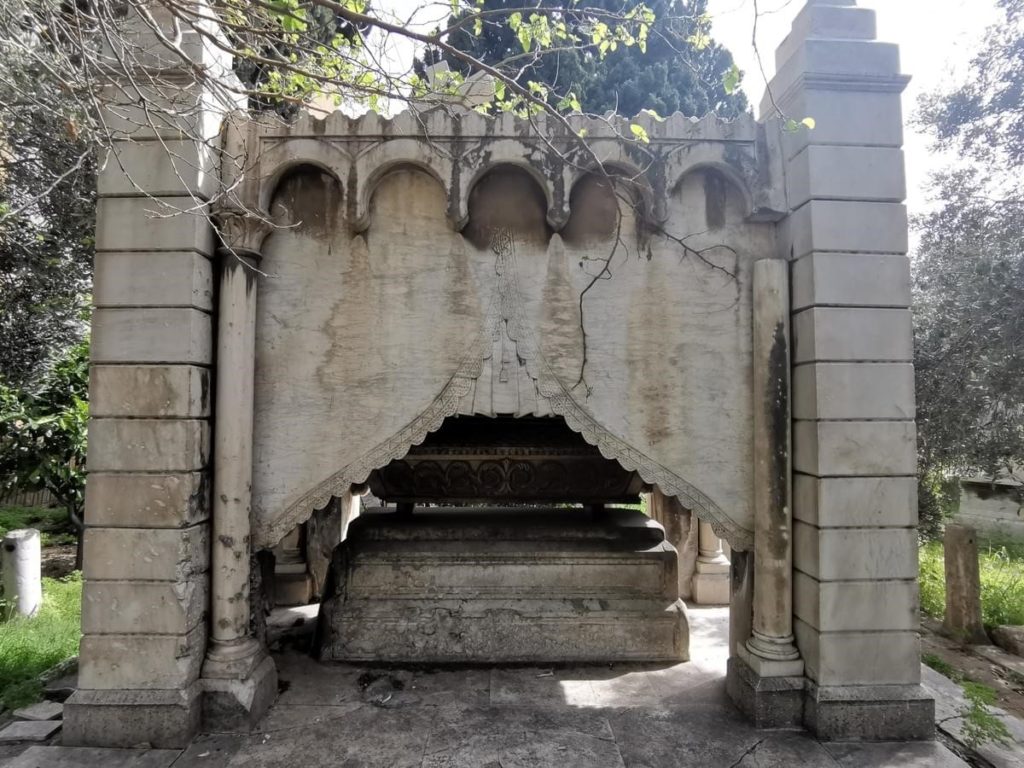
Tomb No.5 – Fuad Franco Cussa: Little is known about the life of Fuad Franco Cussa although it seems probable that he was one of four sons of Franco Pasha. The other sons, Nasri Franko, Yusuf Franko, and Fethi Franko all achieved high positions in the Ottoman diplomatic service.
The memorial comprises two elements — a lower structure in the form of a traditional rectangular cenotaph or chest tomb and an upper part in the form of a Roman funerary alter.The north and south sides of the upper part of the monument are decorated by relief carvings of laurel wreaths while the east end carries a depiction of a lyre. The west end of the upper structure carries a bilingual inscription panel in French and Arabic.
Lower Part of Inscription (French): ICI REPOSE FUAD FRANCO CUSSA NE A CONSTANTINOPLE LE 16 FEVRIER 1859 DÉCÉDÉ À BEYROUTH LE 30 AVRIL 1896 PRIEZ POUR LUI ———— BIENHEUREUX CEUX QUI ONT LE CŒUR PUR CAR ILS VERRONT DIEU MATTH.V.8.
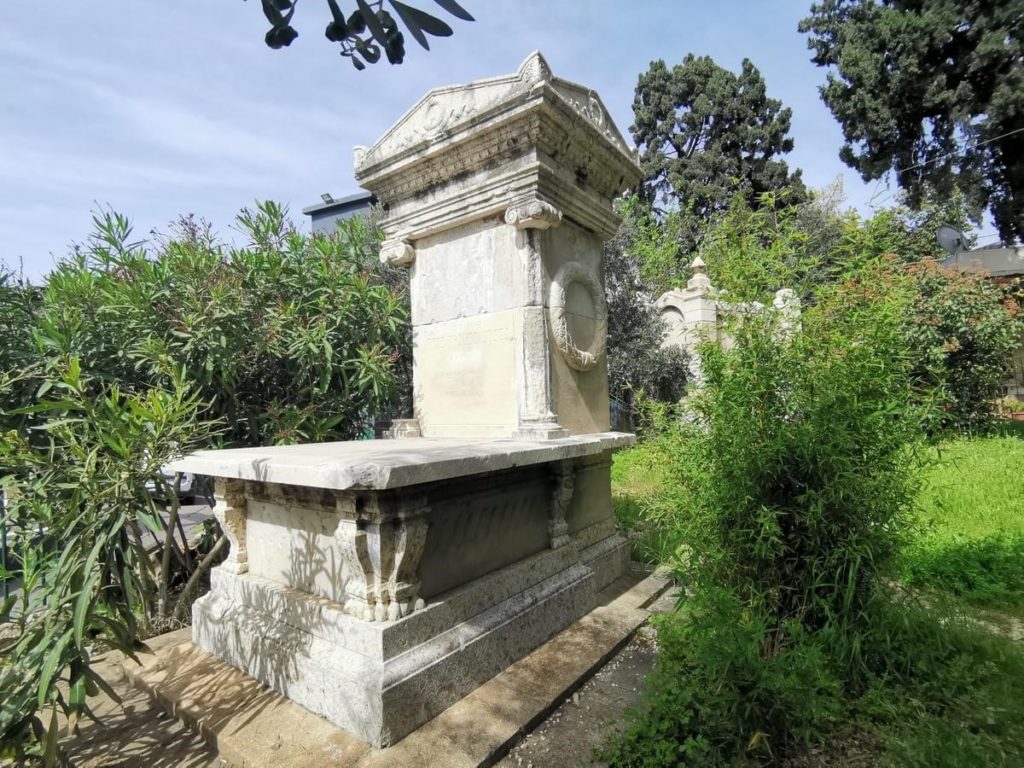
Tomb No.6 – Tomb of Wassa Pasha: Wassa Pasha was born in Scutari (Skodra) in Albania to a Roman Catholic family. His education included a period in Rome where he studied languages and literature. In 1830 Wasa moved to Constantinople where he entered a career in the Ottoman government which included a posting to the Ottoman embassy in London where he held the position of counsellor (müsteșâr ). During his role as governor of Lebanon he improved the infrastructure of the territory although he was accused of corruption. The later part of his governorship was plagued by ill health and he finally died on June 26, 1892. Given his significance for Albanian nationalism, Wassa Pasha’s body was removed to Shkroda in 1978.
The monument comprises a square platform accessed via a set of steps on the west side. In the center there is a tall neoclassical structure in the form of a miniature building with a gabled roof. At each of the gable ends of the monument there are inscriptions—on the east side in the form of a plaque and on the west side on the replicated surface of a curtain. The decoration framing the inscriptions on both west and east faces is identical and comprises elaborate based on floral/vegetal themes. Both inscriptions are framed by columns with Corinthian capitals set beneath a pointed arch or hood molding. At the base of each column there is a depiction of a flower in the form of a crucifix. Within the tympanum of each arch there is a moulded relief depiction of a pine cone and two split palmettes. Both arches are surmounted by a carved representation of laurel wreath.
Inscription south face (French): MONUMENT ELEVÉ ALAMEMOIRE DE WASSA PACHA GOUVENEUR GENERAL DU LIBAN DÉCÉDÉ LE 29 JUIN 1892 PRIEZ POUR LUI
Inscription north face (Arabic): سبحان الحي الباقي هذا الضريح المحوم واصا باشا مت صرف جبل لبنان توفاه الله في التسع العشرين من شهر حزيران سنة ١٨٩٢ صلوا الاجله
Translation: His mercy endureth forever This monument of the forgiven Wassa Pasha Mutasarraf of Mount Lebanon Passed away in 29th Of the month of June in 1896 Pray for Him.
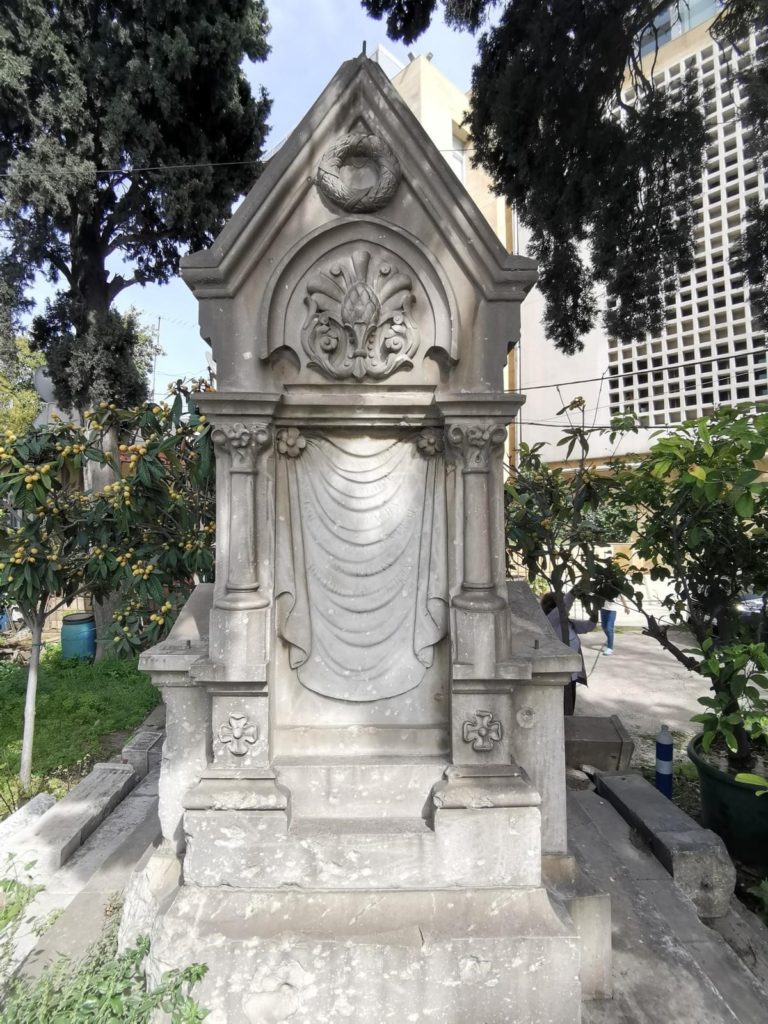
Tomb No.7 – Tomb of Rosa Wassa: Little is known of the biography of Rosa except that she was the daughter of Wassa Pasha from his first marriage to Drande and was married to Kupleyan (Küpeliyan) Effendi who was head of the foreign correspondence bureau.
This tomb is close to the tomb of Wassa Pasha. The tomb is difficult to see as it is entirely surrounded by a series of laurel bushes. The building is roofed with a six-pointed cross vault made of tall pointed arches meeting at an apex crowned with a floral motif. It is open on all six sides making the interior visible from all directions. In the center of the monument, there is cenotaph comprising a rectangular base supporting a full size representation of a coffin decorated with vines crolls very similar to that inTomb No.4 marking the grave of Catharina Wassa Pasha. The interior of the roof has the appearance of a tent or pavilion
Inscription west (French): ICI REPOSE LA BIEN REGRETTEE ROSA KUPELYAN WASSA DÉCÉDÉE LE 27 JANVIER 1887 AL’AGE DE 28 ANS PRIEZ POUR
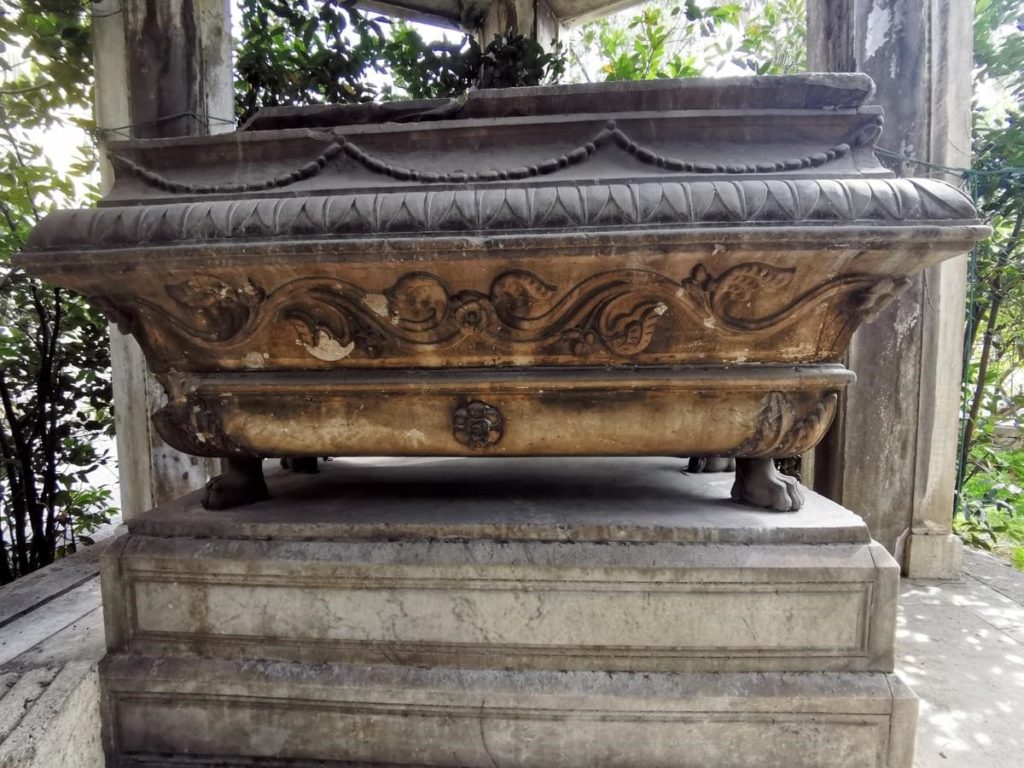
Karim Sokhn
Tour Operator & Tour Guide
References:

